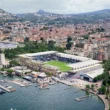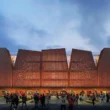Ups and downs and evolution of a symbol of italian modern architecture.
San Siro is an icon. A stadium that acquired an incredible fame through its history, becoming a place of football known to and loved by every fan in the world.
Nicknamed “La Scala del Calcio”, in reference to the famous theatre of Milan, the San Siro stadium is a sum of hardness and elegance, perceived between its ramps and high towers and symbolic of a century of Italian football, seen through the sports tradition of the city of Milan and “Milanesi” people.

The ground was opened on 19 September 1926, with a Milan v Inter derby game ended in a flamboyant 3-6 for the Nerazzurri. Built on the then Municipality of Trenno, merged with Milan just two years earlier, the stadium wasn’t just a football ground but also the central piece of a city multi-sports area around it.
Close to the adjacent racecourse Ippodromo del Trotto, the new structure served as a logistical support with rooms conveniently built under the grandstand to be used as stables for horses and forage warehouses.
An English San Siro
There was, therefore, a close relationship between the two buoldings, with the new football ground in deference to the horse racing activities back then. The name of the stadium, as well as for the neighbourhood’s, comes from a local church, the Chiesa di San Siro alla Vepra, built before the year 1000 AD, and of which the apse remains still visible today, enclosed within the structure of a late-19th century villa in via Masaccio.
The first San Siro could accommodate 35-40k fans and was built in just over 13 months in a classic English-style. The engineer Alberto Cugini and, above all, the architect Ulisse Stacchini were the men beyond the design: faithful to Art Nouveau style, Stacchini was responsible for the Liberty-styled design of various residential buildings in Milan.
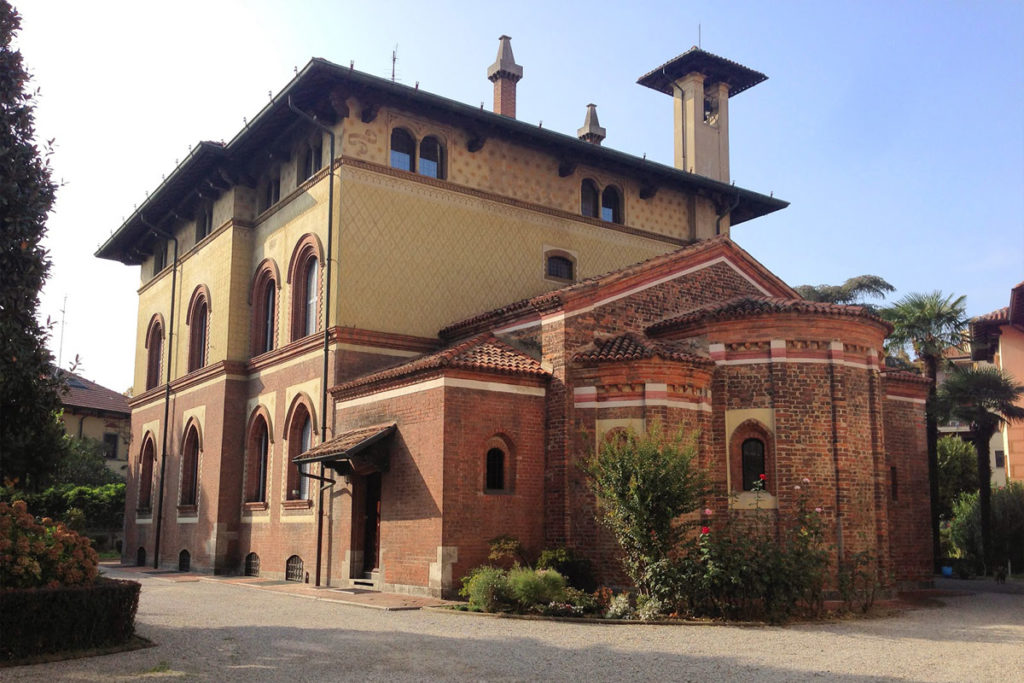
Furthermore, he will also gift the marvellous railway station “Stazione Centrale” project to the city, almost the same age as the football ground here mentioned and very well known for its wonderful covered atrium inspired by the German taste of the time.
Back to the original stadium, it cost less than 2 million lire of the time and became the new AC Milan home, while Inter Milan kept on playing at the Arena Civica, where they would eventually remained until the Second World War. The ground consisted of 4 independent stands of different heights with only the main grandstand covered (today the Red stand). A few Neoclassical elements marked the exterior, in particular the tympanums of the entrances to the grandstands and a cornice following doors and windows sequence.
A funny note is that the man responsible for the whole idea of the stadium was Piero Pirelli , the then president of AC Milan and son of Giovan Battista Pirelli, founder of the famous tire manufacturing company… which many years later would become the historic sponsor of Inter Milan!

Football’s potential wasn’t clear to people in the 1920s and the new Milan stadium was indeed simple enough to host games, instead of being marvellouse or whatever.
Things began to change towards the end of the 1930s: the stadium ownership went in the hands of the city of Milan in 1935, while the two teams were gaining good results on the pitch and more and more following outside.
This is why a first expansion project came on the cards, with a design made by engineer Bertera and architect Perlasca, for the construction of the 4 corner stands which created an enclosed structure which shaped the fundamental structure that still survives nowadays.
Stadium capacity at this time rose to 60-65k (and unofficially declared of 150k) and until 1950 the San Siro Stadium was considered the largest stadium in the world.
The second half of the 20th century
After the end of the Second World War football really became the greatest passion of italian people and AC Milan won the Serie A in 1951, after almost forty years of wait. That’s when a bigger ground was needed.

It seems like chronicles of a debate that we hear nowadays but it took place over half a century ago: renovating San Siro or building a new stadium? And more on this, better a new facility that could also accomodate an athletic track (in view of a possible Olympic bid) and to be built at a short distance from the actual ground, or to move both the clubs to the Arena Civica?
Paradoxically, AC Milan and Inter Milan did want to move to the Arena, in the city centre: some renovation works were needed but that historic stadium also guaranteed better services and an even greater capacity.
In the end, however, conservation prevailed: the second main expansion project of San Siro history, outlined by engineer Calzolari and architect Ronca (1955) kept the existing bowl and added a second tier above it, statically supported by a bundle of helicoidal ramps which externally enveloped the original structure. An architectural trace of enormous value, built in only 500 days of work and allowing all the games to be still played during the construction work.
The stadium, thus renovated, would become the home of Rivera and Mazzola, Helenio Herrera and Nils Liedholm, the famous Mark Hateley’s derby goal and the magical 70s and 80s.
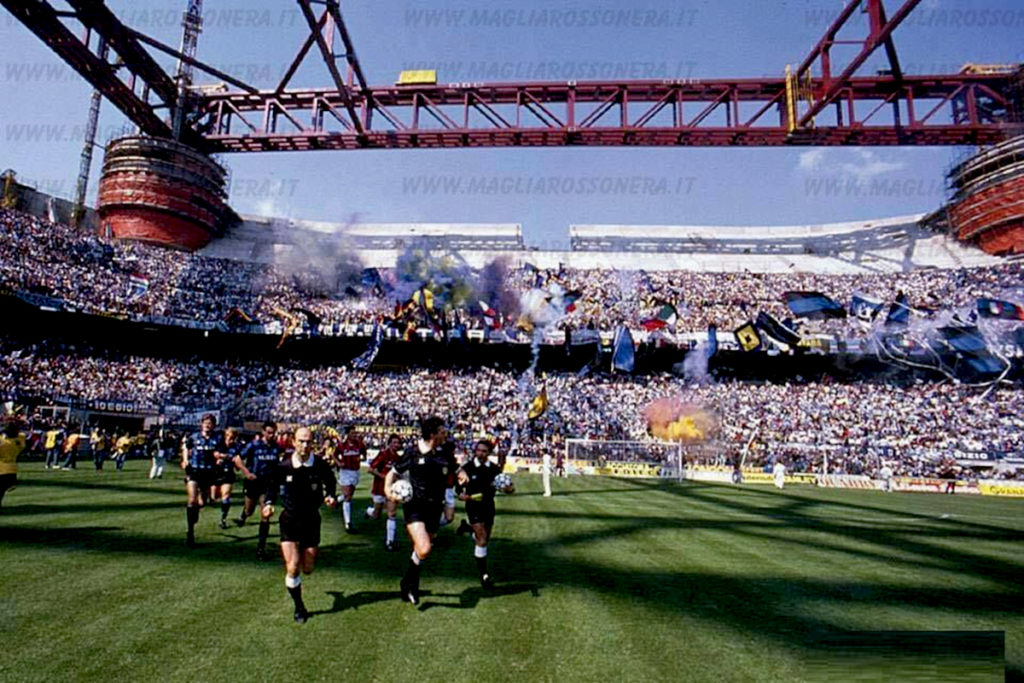
Postcards showed fascinating general views of the ground surrounded by hundreds of cars parked in the area, with rows of trams frantically arriving and departing from the south square and a classic foggy atmosphere inside the bowl. Those were the decades when San Siro became the symbol of the city of Milan, of its people, of its habits.
Notti Magiche – Italia 90
The stadium, in the meantime entitled to the late Giuseppe Meazza, would remain untouched until one of the biggest turning point of european football: 1990 World Cup.
In view of this event, the San Siro underwent a major refurbishment which changed its perception forever. With a project by architects Ragazzi and Hoffer, still faithful to a general idea of evolution, the existing structure was enveloped by new elements: 11 cylindrical towers leaned just against the second tier and acting as the only support for the new third tier and the new roof.
The Tribuna Arancio, on the racecourse side, avoided the expansion due to lack of space on via Piccolomini.
The roof became the icon of the project, rising above the four main corner towers and supported by a system of huge trusses painted in a bright red colour, a proper new symbol of stadium.
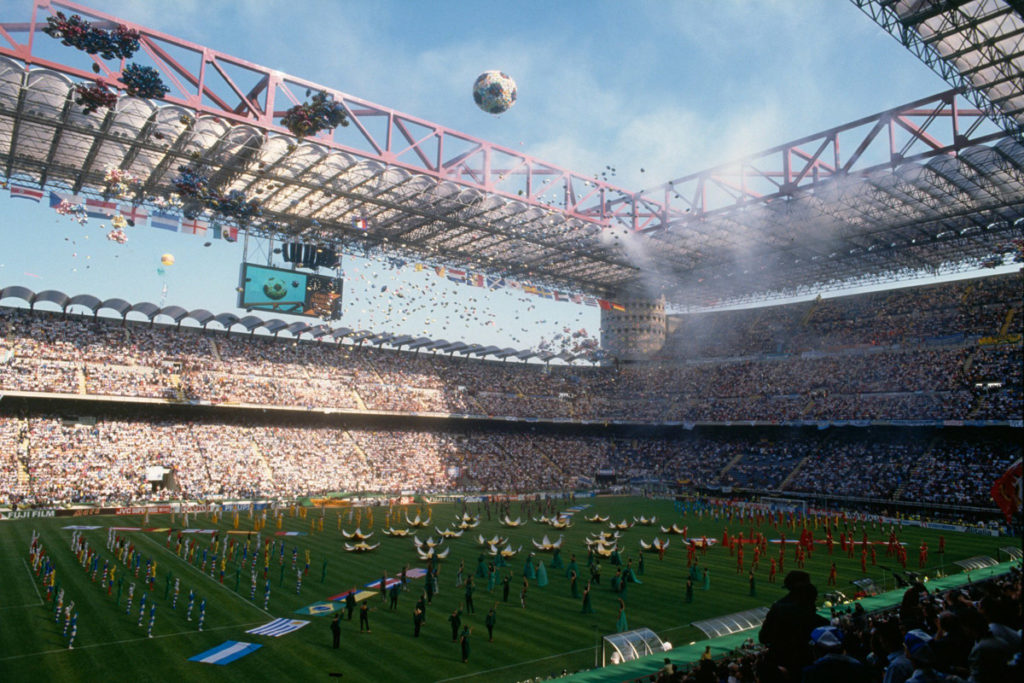
Italia 90 is certainly the step that defined the San Siro epicness.
The third tier has a slope of 37°, almost unmatched in Europe, and gives an extraordinary view above the pitch (very well known to travelling fans as the away section is indeed at the third level of the ground).
The visual impact of the new building, from inside and from the outside, became something unparalleled around the world, majestic for fans, exciting and intimidating at the same time, almost creating the ultimate test for the players that had to prove “they can bear the pressure of playing at the San Siro”.
In the 1990s, the Meazza Stadium greeted the new wizards of modern football, from the Fenomeno Ronaldo to all the stars playing in the Serie A and european cups, witnessing the many trophies won by Silvio Berlusconi’s AC Milan and also hosting two Champions League finals (2001, Bayern Munich v Valencia; and 2016, Real Madrid v Atletico Madrid).

Today the San Siro is still marvellous to fan’s eyes.
It’s full of strong contradictions too, though. Since its an architectural version of a Matryoshka doll it retains the strengths and weaknesses of a building that has been renewed over time, layer above layer, without being effectively changed.
A lot has been said about its future, both in the past and in recent years. Contemporary football seems to ask for its departure, AC Milan and Inter Milan seem unable to understand that a refurbished San Siro would still be more powerful than a new ground built from scratch. But still, modernisation is needed, structurally and functionally.
Every fan walking from the open piazza towards the stadium is just amazed by the imposing figure of the building. It gives you shivers, no matter what. And there are very few stadiums doing so in the world.
Despite everything, however, after almost 100 years of life San Siro best sums up the meaning of a sports venue of our time: it represents a century of italian football, the evolution of italian Modern architecture, the meaning of the city of Milan way of life.
You can find more on “TSPORT – Sporteimpianti”, the most renowend sports architecture and technology magazine in Italy, here


